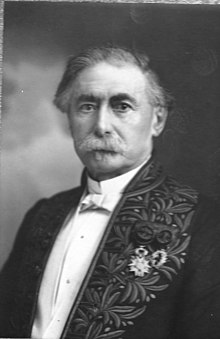Émile Amagat
Émile Hilaire Amagat (2 January 1841, Saint-Satur – 15 February 1915) was a French physicist.[1] His doctoral thesis, published in 1872, expanded on the work of Thomas Andrews, and included plots of the isotherms of carbon dioxide at high pressures.[2] Amagat published a paper in 1877 that contradicted the current understanding at the time, concluding that the coefficient of compressibility of fluids decreased with increasing pressure.[2] He continued to publish data on isotherms for a number of different gases between 1879 and 1882,[2] and invented the hydraulic manometer, which was able to withstand up to 3200 atmospheres, as opposed to 400 atmospheres using a glass apparatus.[3] In 1880 he published his Law of Partial Volumes.
Émile Hilaire Amagat | |
|---|---|
 | |
| Born | 2 January 1841 |
| Died | 15 February 1915 (aged 74) |
| Nationality | French |
| Known for | Amagat's law, Hydraulic Manometer |
| Scientific career | |
| Fields | Physics, Thermodynamics |
Amagat was elected a member of the French Academy of Sciences on 9 June 1902.[4] A unit of number density, amagat, was named after him. He was elected a foreign member of the Royal Society of London in 1897.[5]
The French Academy of Sciences gave him the posthumous award of the Prix Jean Reynaud for 1915.[6]
In film
- In 2016 Polish film Marie Curie, Amagat was played by Daniel Olbrychski.
References
- larousse.fr Émile Amagat
- Daintith, John (1981). "Amagat, Emile Hilaire". Biographical Encyclopedia of Scientists. 1. New York: Facts On File, Inc. p. 15. ISBN 0-87196-396-5.
- Bridgman, P. W. (1909). "An absolute gauge for measuring high hydrostatic pressures". Physical Review. Series I. American Physical Society. 28 (2): 145. Bibcode:1909PhRvI..28..140.. doi:10.1103/PhysRevSeriesI.28.140.
- Payen, Jacques (1970). "Amagat, Émile". Dictionary of Scientific Biography. 1. New York: Charles Scribner's Sons. pp. 128–129. ISBN 0-684-10114-9..
- Barus, Carl (1899). The laws of gases: memoirs by Robert Boyle and EH Amagat. 5. Harper & Brothers. p. 107.
- "Séance du 18 décembre". Le Moniteur scientifique du Doctor Quesneville: 67–69. February 1916.